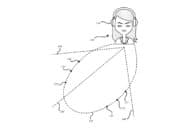Hal CrainOwner, Crain Ranch nut farm and processing facilityLos Molinos, California
I woke up at 4:30 today. Right now, the end of September, this is right in the middle of walnut harvest season. I’m still wearing my work clothes every day, going out into the field every day.
This story is one of a series about how hidden innovations produce the foods we eat at the prices we pay. It has been edited for length and clarity. As told to Krithika Varagur.So the shaking operation comes first. You shake the trees, drop the nuts onto the ground. Then you have these mechanical sweepers that basically sweep all the nuts off the ground and into windrows, about three feet wide, all in a big, long line on both sides of each tree. Behind that goes a pickup machine, or a harvester, that picks them up off the ground, separates the dirt, sticks, and leaves, and puts them into trailers, leaving them much cleaner than what got picked up off the ground. Then from there, they get trucked to the huller, which removes the green husk off of the nuts that still have it on—30 or 40% of them—and cleans them and washes them. And the last phase is a dryer, where they go on these huge storage containers with forced air, heated air, being pushed through the storage containers to get the nuts down below 8% moisture.
Once that’s done, then they’re stable enough to be sent to the processing warehouse to be further processed, cracked, packed—whatever is going to be done with them. For the unshelled ones, which are about 95% of our output, we run them through processors with food-grade, natural cleaners, to try to make them as aesthetically pleasing as we can.
I’m a second-generation walnut farmer. In terms of how much mechanization has changed our work, it’s been like going from the Model T to the Tesla, but in a much shorter time. I’m 51 now, and when I was a youngster they didn’t even have a way to mechanically shake the trees. We would just get poles and knock [the nuts] out of the trees, or wait for them to fall, over months and months. Today, each harvest crew will pick over 500,000 pounds of nuts a day, versus about 2,000 pounds when it was mostly manual.
The processing, the packing, the sorting is all mechanical. Sorting out the defective nuts is all done via laser, with these WalnutTek machines by WECO, a company that specializes in electronic sorters. The ones being sold in-shell get scanned for shell defects. There are even ways to detect if a kernel is not full inside the shell. There are all kinds of other shell defects, like a partial husk or dark spots from sunburn that discolors the shell, which in turn means the kernel won’t be very good quality. All of those defects are mechanically sorted. And plenty of other things, from insect damage to mold to shell particles. The human eye is the last factor before it goes into packaging, just to make darn sure that nothing is missed. Like if you have insect damage, you can visually see that.
We’re in the far north end of California and it’s going to reach 97 degrees today. It’s low humidity. It’s not desert by any stretch; we have significant rainfall. But we get really hot during the summer. We’re just starting to use something called the FloraPulse, a plant water stress sensor, on our almond trees, which are about 10% of what we grow, and hopefully soon the walnut trees too. If I plug this device into a given tree and get a measure on that, I can adjust my frequency of irrigation to maximize tree health and crop longevity. Basically, the tree can tell me how thirsty it is. This is a big step in trying to actually get a direct measurement of plant stress and then identifying the parameters of what’s ideal at certain times of the year.
Powered by WPeMatico


